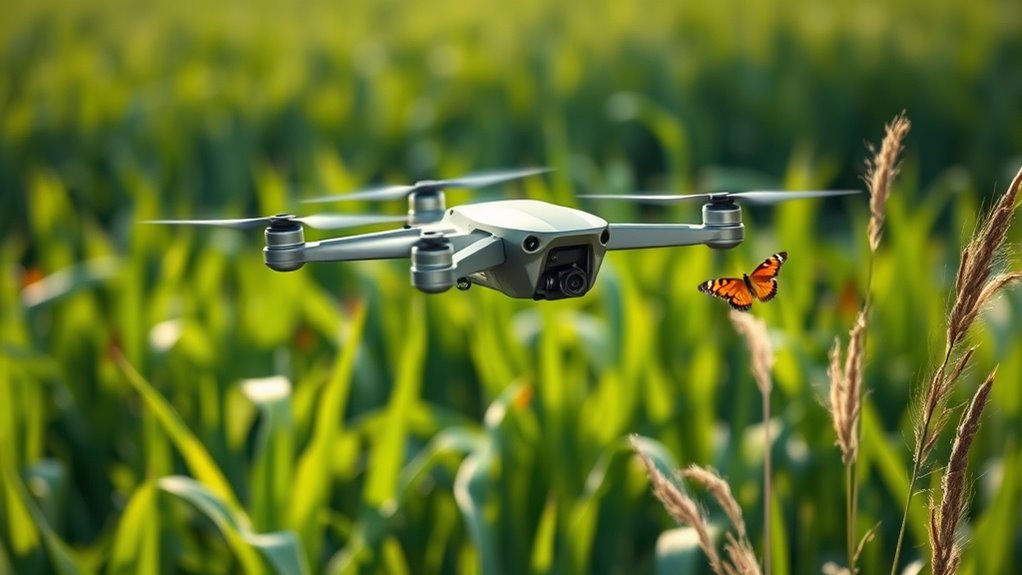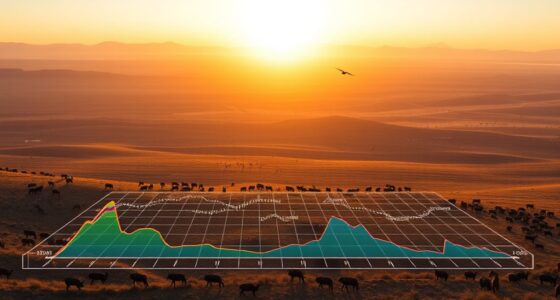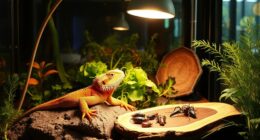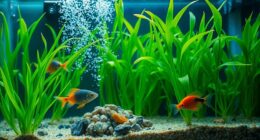Rabbit-sized drones help you monitor crops effectively without disturbing wildlife or ecosystems. Equipped with advanced sensors and autonomous navigation, these tiny drones can easily fly over fields, collecting high-resolution images and data on soil moisture, plant health, and pests. Their small size and quiet operation minimize environmental impact, making them ideal for sensitive areas. Want to discover how these innovations can transform your farming practices? Keep exploring to learn more about this game-changing technology.
Key Takeaways
- Small, rabbit-sized drones can navigate large fields independently, covering crops efficiently without disturbing wildlife.
- Equipped with advanced sensors, they collect detailed environmental data without causing habitat disruption.
- Their quiet operation minimizes noise, reducing stress on birds, pollinators, and other wildlife.
- Durable design allows them to operate reliably in various weather conditions near sensitive ecological zones.
- Their non-intrusive monitoring supports sustainable farming while preserving local ecosystems.
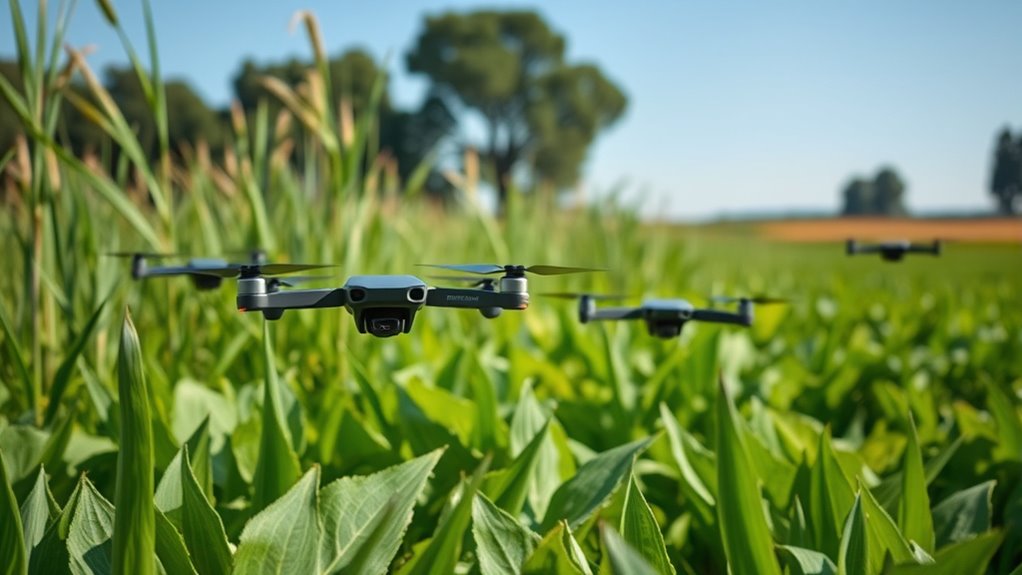
Thanks to recent advancements in drone technology, farmers now use rabbit-sized drones to monitor their crops more efficiently. These tiny drones are equipped with sophisticated sensor technology, allowing them to gather detailed data without disturbing the natural environment. Their small size and advanced features give farmers a powerful tool to keep their fields healthy while minimizing ecological impact.
One of the key features of these miniature drones is their autonomous navigation capability. You don’t have to manually pilot them; instead, they can independently follow pre-programmed routes or adapt on the fly based on real-time data. This autonomous navigation guarantees thorough coverage of large fields with minimal human intervention, saving time and reducing labor costs. You simply set the parameters, and the drone handles the rest, flying low and slow to capture high-resolution images and multispectral data.
Miniature drones autonomously navigate fields, capturing high-resolution images and multispectral data with minimal human input.
Sensor technology plays an essential role in how these drones operate. They are packed with sensors that detect a wide range of environmental factors, such as soil moisture, plant health, pest activity, and nutrient levels. These sensors provide you with instant insights, allowing for targeted interventions like precise watering or pest control. Since the drones can fly close to the crops, their sensors capture detailed information without causing damage or disturbance to wildlife or the plants themselves. This non-intrusive approach helps you maintain a balanced ecosystem, avoiding the stress or disruption that larger or noisier machinery might cause.
Because of their small size and quiet operation, these rabbit-sized drones are less likely to scare away wildlife or disturb delicate habitats. You can deploy them frequently without worrying about disrupting bird nests, pollinators, or other fauna. Their discreet presence means you get consistent monitoring data without negatively impacting the local environment. This ability to work quietly and unobtrusively is a game-changer for farms located near sensitive ecological zones.
Furthermore, these drones can operate in various weather conditions, thanks to their durable build and intelligent navigation systems. They can adapt to changing light, wind, or temperature, guaranteeing you get reliable data no matter the circumstances. This resilience means you can keep tabs on your crops even during less-than-ideal weather, helping you make informed decisions promptly. Additionally, their compact design makes storage and transportation easier for farm operations.
Frequently Asked Questions
How Long Can These Tiny Drones Operate on a Single Battery Charge?
You wonder how long these tiny drones can operate on a single battery charge. Typically, their battery life lasts about 20 to 30 minutes, depending on usage and environmental factors. To keep them flying longer, you can set up charging stations in your fields, allowing quick recharges between flights. This way, you guarantee continuous monitoring without interruptions, making your crop management more efficient and less disruptive to wildlife.
Are Rabbit-Sized Drones Cost-Effective for Large-Scale Farming Operations?
You’ll find that rabbit-sized drones can be cost-effective for large-scale farming when you compare their cost and maintenance expenses to traditional methods. Their lower initial investment, combined with minimal maintenance costs, makes them appealing. Plus, their ability to monitor vast areas efficiently reduces labor costs. While the upfront price might be higher than some alternatives, the long-term savings and quick data collection can make them a smart, economical choice for your farming operations.
What Safety Protocols Are in Place to Prevent Drone Malfunctions?
You’d think a drone could never malfunction with all these safety protocols, right? Well, these tiny drones have robust measures like advanced autonomous navigation that keeps them on course and emergency landing procedures that act instantly if something goes wrong. These safeguards are so reliable, they’re practically guaranteed to protect your crops and wildlife. Rest assured, safety is top priority, and these protocols make drone operation safer than ever before.
How Do Farmers Control Multiple Drones Simultaneously?
You control multiple drones by using centralized software that manages autonomous navigation, allowing seamless coordination. This system enables you to assign specific areas or tasks, ensuring efficient coverage. You also optimize battery usage through smart management, scheduling rotations when batteries need recharging. By leveraging real-time data and automation, you can oversee numerous drones simultaneously, reducing manual effort and maintaining continuous crop monitoring without disturbing wildlife.
Can These Drones Detect Pests or Plant Diseases Directly?
Think of these tiny drones as detective bees, always on patrol. They can indeed detect pests and assess plant health directly, using advanced sensors and imaging technology. By scanning crops closely, you’re able to pinpoint pest infestations or diseases early, saving your fields from widespread damage. This real-time pest detection and plant health monitoring help you make smarter, faster decisions, keeping your crops healthy without disturbing the natural ecosystem.
Conclusion
Imagine walking through a farm where tiny, rabbit-sized drones quietly survey your crops without scaring away the wildlife. These drones could help you spot problems early, like pests or disease, saving time and money. For example, a farmer using these drones might notice a small patch of unhealthy plants before it spreads. With this new technology, you can protect your crops and wildlife simultaneously, making farming smarter and more sustainable.
